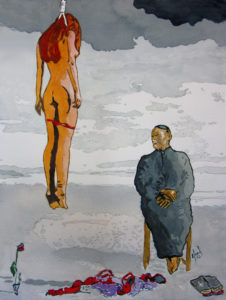
In the past three decades over five million white adults have left the church. These stark numbers come from recent surveys by Pew and National Opinion Research.
Five million.
Evangelicals have represented a huge majority of the American population throughout history and in 1991, white Christians constituted about 75% of all adults. But in three short decades, they have fallen below majority status for the first time. Today they compose about 40% of the population. And the blasphemous alliance with Trump is escalating the attrition exponentially.
I am one of those five million. I am also a creative. And while I can find no survey numbers, empirical data tells me that an inordinate percentage are artists. Here are three reasons I believe that creatives are fleeing the church in droves.
1) Creatives Tend To Be Misfits—Creatives are round pegs in square holes. We don’t fit in places that have rules and where we are not allowed to look at things differently.
The church by its very nature produces clones, but creatives demand originality. The church has little interest in, and tolerance for, the value of the individual. When I asked the church to help create a retreat for people who are wounded and weary, they asked me “How will that put butts in the pews?”
The evangelical mega-church with its faceless masses has exasperated this problem. Even though my title was Pastor of Arts, internally the executive pastors called me the Director of Marketing. My job was not to create art, my job was to put on a good show to attract larger numbers of butts. Particularly those who thrive on rules and want to disappear in a crowd.
But misfits are crazy, we are rebels, we are troublemakers. And you can try to repress us, shame us, and ostracize us, but the only thing you can’t do is ignore us. We change things. We push the envelope, and we are crazy enough to think that we can change the world.
And many of us now know that we don’t need the church to do it.
2) Creatives Tend To Be Monsters—Last Thursday was Hallowe’en. I often imagine what people look like behind their masks. And then, I think about how we mask ourselves to do life at church, and how unmasking makes us vulnerable.
We all wear masks. And underneath those masks monsters are lurking.
Sadly, the church has created the most insidious monster ever. Most Christians are repressed and they are ashamed of who they have become. They have sacrificed themselves—emotionally, physically, mentally, and spiritually—on the altar of self-denial.
And they know that if they take off their mask in public, they will look different than a Christian should look. In the privacy and secrecy of their homes, they sometimes gather the courage to take off the mask, just for a moment, and they are no longer able to recognize the person underneath.
Creatives are foolish enough to take off their masks in public. To openly expose the “monster” within—to admit they love sex, and drugs, and rock and roll. In fact, they will go to great lengths to break rules and taboos—even if it means breaking themselves in the process.
Unlike the church, they believe that the human body is wondrous, mysterious, and magical, and should be treated not only with respect but with reverence, perhaps even awe. And unmasked (and unclothed) as often as possible. They know it is a sick person who is unmoved by the sight of a pretty breast. They know that the guilt strategy the Church preaches is not good for art.
Creatives may be monsters but they know that the scariest monsters are the Christians who hide their sins and shoot their wounded, and fear and loathe anyone or anything that is different.
3) Creatives Tend To Be Mystics—My wife and muse Gina insists that I am a mystic. I’m not sure. Of course, my uncertainty simply makes her more convinced. Have you ever wondered, “Am I a mystic?”
Mysticism can often be complicated and confusing. Somewhat like the Existentialists, mystics believe that direct knowledge of the truth can be attained through subjective experience. Unlike Christianity, mysticism is not rooted in faith, principle, dogma, or even belief.
For mystics, the world is expansive and magical yet also interconnected. They feel a need to serve others in order to help guide them through obstacles and critical life decisions. Their ability for intuition and communion is unique and is derived from within.
The website Gaia lists the subtle qualities of a mystic. Mystics value experience above all else and question existence. They are comfortable with uncertainty and value intuition. They are uncomfortable with spiritual hierarchies and eschew rules. Mystics value internal growth and believe they are a conduit for power—not the source. They believe love is the source of life and they question everything.
In Conclusion—A look back through history shows that creatives and the church are not good bedfellows. From the light-filled beauty of Botticelli’s nudes to the dark disillusionment of Van Gogh, from the philosophical introspection of Nietzsche to the contemporary entertainment of Katy Perry and Justin Timberlake—these misfits, monsters, and mystics all fled the church.
And our world is better for it.
If they had stayed in the church we would likely not have the paintings “The Birth of Venus,” and “The Starry Night,” and the book “Thus Spoke Zarathustra,” nor the songs “Firework,” and “Cry Me A River.”
And far less notably, you would not have this post. I’m so grateful and proud to be a misfit, a monster, and perhaps even a mystic—and that somehow I did not allow the church to spank, repress, or shame the creativity out of my being.
Leave a Reply